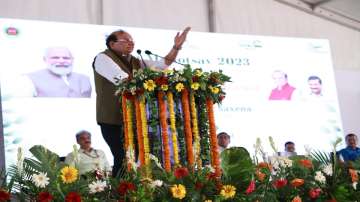Delhi L-G Vinai Kumar Saxena writes to CM Arvind Kejriwal listing key factors that caused massive floods
Delhi waterlogging: The L-G, based on analysis done by experts and officers of the concerned agencies, has highlighted the lapses on the part of the government and suggested measures.

Delhi waterlogging: Delhi Lieutenant Governor Vinai Kumar Saxena on Friday (August 18) wrote to Chief Minister Arvind Kejriwal listing all major factors that caused massive floods in the national capital, even as the Yamuna River continues to flow above the danger level.
The L-G, based on analysis done by experts and officers of the concerned agencies, has highlighted the lapses on the part of the government and suggested measures.
"The highest recorded discharge of 8.28 lac cusec from Hathni Kund was in 2019, which resulted in the water level in Yamuna at the Old Railway Bridge (ORB) touching the 206.6-meter mark, whereas, the discharge this year was only 3.59 lac cusec, yet the Yamuna level reached the record level of 208.66 meters at the ORB," the letter read.
Out of the 44 km of Yamuna in Delhi, the 22 km stretch from Wazirabad to Okhla has 18 major obstructions inside Yamuna, resulting in impeding the free flow of water. Outdated and inaccurate level-based discharge computing table held by DJB to compute the discharge at Wazirabad Barrage, it added.
"The unprofessional practice of the government departments of not clearing the C-D and other Waste from bridge construction sites that obstruct the free flow of Yamuna. These man-made obstructions significantly reduced the velocity of Yamuna water that resulted in water at an increased level, staying within the City limits for an additional approx. 06 hrs," the letter read.
The letter further stated that heavy accumulation of silt in Yamuna over the last several years and lack of desilting/dredging in Yamuna.
The Delhi Jal Board had laid a water pipeline across the mouth of Drain No 12 opposite WHO Building and, in the process, demolished the existing Bund over there. The same was not repaired by the DJB, which resulted in water from the river gushing into the Drain and collapsing Regulator No 12 on the mouth of the Drain. This in turn led to water rushing into the city in areas around WHO, ITO and up to the Supreme Court, L-G said in a letter.
"The upstream level of the Wazirabad barrage is supposed to be higher than the downstream level by approx. 4 feet. However, due to heavy siltation around the barrage, both are almost at the same level now, it said. There was not one single department/agency that had ownership of Yamuna, especially during the floods, it said.
Meanwhile, as a way forward, L-G has also suggested the following measures, The L-G said that "Assign permanent ownership of the Yamuna River stream, to one department, on the lines of DDA being the exclusive owner of the Yamuna flood plain, and put all other stakeholder departments as adjuncts tasked with specific responsibilities."
Handing over all the pumping installations at Regulator locations to a single Department to enhance operational and maintenance efficiency. There is an urgent requirement for coordinated action by CPWD and PWD to ensure hassle-free drainage from Rajghat and Samadhi Complex, L-G said."The hydrographic profile of Yamuna in terms of width, depth and height be ascertained and sustainable desilting/dredging, pending for the last 10 years, be undertaken, at the earliest," it added.
Hence, there is a need to carry out a fresh topographical, hydrodynamic and hydrographic study to plan required remedial measures to cater for discharge of upto approx. 10 lac cusec from Hathni Kund in future.
Moreover, the long pending Drainage Master Plan of the City, with a detailed study of the drains, the requirement of additional regulators and detailed drainage and siltation patterns, needs to be put in place at the earliest. Desiltation of the Najafgarh Drain be carried out at the earliest in a time-bound manner, it said. L-G further said that the detailed annual Flood Control Plan be made well in time and measures be put in place by June 10 every year, about 20 days ahead of the scheduled date of onset of monsoon in Delhi.
Zero tolerance towards encroachments on the river bed and the floodplain in the future. Selective dredging of Yamuna is carried out especially, of the critical and crucial stretch between Wazirabad- ITO Barrage, it added. Furthermore, an advanced Flood Management Plan for Yamuna Bazar and other low-lying areas be put in place now.
(With ANI inputs)
ALSO READ: Rain lashes parts of Delhi-NCR, brings relief from scorching heat, humidity | VIDEO